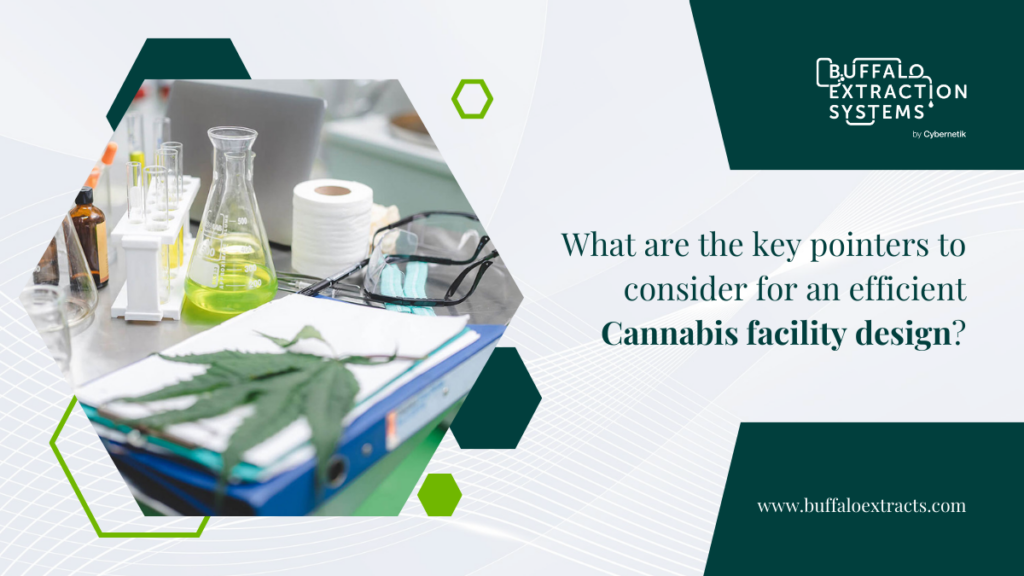Key Pointers for Designing an Efficient Cannabis Facility
The rapidly rising demand for cannabis has led to a surge in the establishment of cannabis cultivation and processing facilities. In the dynamic landscape of the legalities in cannabis cultivation and processing, designing an efficient cannabis facility is a pivotal undertaking.
Striking an intricate balance between adhering to stringent regulations, optimizing resource utilization, and producing top-tier cannabis products requires meticulous planning and execution. From complying with local laws to ensuring the highest standards of quality control, every aspect demands careful consideration.
This article delves into a comprehensive array of key pointers essential for an efficient cannabis facility design. By addressing these aspects, cultivators and industry players can establish a robust foundation for a facility that not only meets regulatory guidelines but also thrives in a competitive market. All of the above while prioritizing product excellence and operational efficacy.
Following are some key pointers to consider while designing a cannabis facility:
- Regulatory Compliance and Zoning: Before embarking with design, it is essential to thoroughly understand the legal and regulatory requirements governing cannabis cultivation and processing in your jurisdiction. These regulations can vary significantly from region to region, and can impact the various aspects of facility design, including location, security measures, waste management, and environmental considerations.
Zoning requirements also play a critical role, as certain areas might be designated for industrial use, making them more suitable for cannabis facilities. Ensuring compliance with local laws from the outset will prevent costly redesigns and potential legal issues.
- Facility Layout and Flow: An efficient cannabis facility layout should prioritize a streamlined workflow that minimizes unnecessary movement and optimizes resource usage. The layout should be designed with distinct zones for different stages of cultivation and processing, such as propagation, vegetation, flowering, and drying.
The flow should be sequential, starting from the input of raw materials or plants to the final packaging and distribution stages. Proper segregation of these areas helps prevent contamination, and ensures quality medical Cannabis extraction production.
- Climate Control and Lighting: Cannabis is a highly sensitive plant, and its growth is influenced by factors such as temperature, humidity, and light. Designing an efficient HVAC (heating, ventilation, and air conditioning) system is paramount to maintaining optimal conditions for cultivation.
Advanced environmental control systems can maintain consistent temperature, humidity, and CO2 levels, leading to healthier plants and increased yields.
- Security Measures: Given the value of cannabis crops and the potential for their diversion into the illicit market, robust security measures are non-negotiable, invariably. The facility should incorporate security features such as access control systems, surveillance cameras, alarm systems, and perimeter barriers.
Security measures not only deter theft, but also help in complying with security regulations that are often mandatory for cannabis operations. Security considerations should be integrated into the facility design from the very beginning to avoid costly and stressful retrofitting solutions later.
- Waste Management and Sustainability: Cannabis cultivation and processing generate waste, including plant material, packaging, and chemicals. An efficient facility design should make provisions for proper waste management and disposal.
Implementation of recycling and waste reduction strategies minimize the environmental impact while also cutting costs in the long run. Incorporating sustainable practices such as water recycling, energy-efficient lighting, and renewable energy sources aligns with the growing demand for environmentally conscious operations.
- Hygiene and Sanitation: Maintaining a clean environment is essential to prevent the spread of pests, diseases, and contaminants that can adversely affect the quality of cannabis products. The facility design should facilitate easy cleaning and disinfection of all areas, Cannabis Ethanol extraction systems equipment, and surfaces.
Non-porous materials, proper drainage systems, and strategically placed sanitation stations contribute to a hygienic workspace that promotes healthy plant growth and product integrity.

- Flexibility and Scalability: The cannabis industry is still evolving, and market demands can change rapidly. Designing a flexible and scalable facility enables easy adaptation to evolving regulations, technologies, Cannabis oil extraction equipment, and consumer preferences. Modularity in CO2 extraction equipment and cultivation spaces allows for adjustments without major disruptions to ongoing operations. This adaptability secures the competitiveness of the facility as well its adaptability to market shifts.
- Technology Integration: Incorporating advanced technologies such as automation, data analytics, and remote monitoring can enhance operational efficiency and decision-making. Automated systems for irrigation, nutrient delivery, and environmental controls reduce labor costs and minimize human error. Data analytics tools can provide insights into plant health, resource usage, and yield prediction, enabling informed decision making for optimized productivity.
- Training and Workforce Considerations: Efficient facility design should also account for the training and safety of the workforce. Clearly defined standard operation procedures (SOPs), safety protocols, and training programs guarantee that employees can operate the Cryogenic Ethanol extraction equipment correctly, follow cultivation protocols, and respond effectively to emergencies. A well-trained workforce contributes to consistent product quality and operational excellence.
- Quality Control and Testing: To address consumer safety and regulatory compliance concerns, cannabis products undergo rigorous quality control and testing processes. Designing an efficient facility includes dedicated spaces for quality control and testing laboratories. Provisions for traceability, sample tracking, and adherence to Good Manufacturing Practices (GMP) or Good Agricultural Practices (GAP) standards are crucial to producing safe and reliable products.
To Conclude
Designing an efficient cannabis facility requires a comprehensive understanding of the plant’s lifecycle, regulatory requirements, and industry trends. By considering key pointers such as regulatory compliance, facility layout, climate control, security measures, waste management, sustainability, hygiene, flexibility, technology integration, training, and quality control, operators can create a facility that not only maximizes productivity and quality but also contributes to the overall success of their cannabis business in a competitive market.
Through careful planning and thoughtful Cannabis facility design, and turnkey solutions for Cannabis, cannabis facilities can achieve operational excellence while meeting the needs of both, the industry and the consumers.
ALSO, YOU CAN READ OUR NEW UPDATE
Are you looking to invest in a Supercritical CO2 extraction machine? Look for these features.
Medicinal Cannabis: What Are Its Benefits To Be Expected In Health Care?

